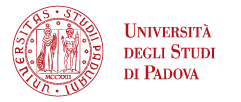CIRCLE
CARIPARO: CXCR4: a marker of neurotransmission failure and a target for neuromuscular function recovery

Acronimo: CIRCLE
Tipo di progetto Nazionale
Tipologia finanziamento Ente Privato/Fondazione Nazionale
Stato del progetto di ricerca Attivo
Grant Agreement Number: 59573
Data avvio: 1 February 2022
Data termine: 31 January 2026
Durata: 48 mesi
Importo: 285.000,00 €
Partners Organizations:
UNIPD - Dipartimento di Scienze del Farmaco
Abstract:
Versione in italiano:
I neuroni periferici possono rigenerarsi grazie alla riattivazione di un programma intrinseco di crescita e a un ambiente di supporto. Negli esseri umani, tuttavia, il recupero complessivo dopo un danno ai nervi è scarso, e vi è una grande necessità di fattori e strategie per migliorare l’esito clinico delle lesioni ai nervi periferici, soprattutto considerando il declino delle capacità rigenerative con l’invecchiamento e nei contesti neurodegenerativi.
Recentemente, abbiamo identificato l’asse di segnalazione composto dalla chemochina CXCL12α e dal suo recettore neuronale CXCR4 come un fattore chiave nella rigenerazione nervosa. È importante sottolineare che l'espressione di CXCR4 aumenta in seguito a una lesione, e un agonista di CXCR4 denominato NUCC-390 ha dimostrato di potenziare significativamente la riparazione nervosa in diversi modelli di lesione acuta, suggerendo CXCR4 come un potenziale bersaglio farmacologico e NUCC-390 come un farmaco neuro-rigenerativo.
In questo studio, proponiamo di:
- comprendere le dinamiche e i determinanti molecolari della ri-espressione di CXCR4 dopo una lesione nervosa;
- separare i due enantiomeri della miscela racemica di NUCC-390 finora utilizzata, isolare l’agonista più efficace di CXCR4 e definirne la farmacocinetica e la farmacodinamica, come nuovo composto stimolante di CXCR4;
- potenziare la rigenerazione periferica nel modello murino SOD1G93A di sclerosi laterale amiotrofica (SLA) tramite la stimolazione di CXCR4, per prevenire la denervazione e la morte dei motoneuroni (MN).
Infatti, poiché l'instabilità precoce e la denervazione della giunzione neuromuscolare (NMJ) sono caratteristiche comuni nei pazienti affetti da SLA e in molti modelli animali della patologia, trattamenti che stimolino la plasticità periferica e la capacità rigenerativa potrebbero prevenire la progressione della degenerazione nella SLA.Combinando saggi in vitro e in vivo, che spaziano dall’elettrofisiologia ai test comportamentali, dall'analisi della funzione respiratoria alla valutazione della sopravvivenza e all'imaging, questo studio mirerà a determinare se la stimolazione di una via pro-rigenerativa a livello periferico possa rappresentare una strategia generale per rallentare la disfunzione neuromuscolare progressiva e proteggere i motoneuroni, contrastando la SLA e altre patologie neuromuscolari.
English version:
Peripheral neurons can regenerate thanks to the reactivation of an intrinsic growth activity program and a supportive environment. In humans, the overall recovery from nerve injury is poor, and there is a great need for factors/strategies to improve the clinical outcome of peripheral nerve injuries, particularly considering the decay in regenerative performance with aging and in neurodegenerative contexts. We recently uncover the signaling axis composed by the chemokine CXCL12α and its neuronal receptor CXCR4 as a major driver of nerve regeneration. Importantly, CXCR4 expression increases upon injury, and a CXCR4 agonist dubbed NUCC-390 strongly boosts nerve repair in several models of acute nerve injury, advocating CXCR4 as a pharmacological target and NUCC-390 as a neuroregenerative drug. Here we propose to: 1) understand the dynamics and molecular determinants of CXCR4 re-expression upon nerve injury, 2) separate the 2 enantiomers from the racemic mixture of NUCC-390 employed so far, isolate the most effective agonist of CXCR4, and define its pharmacokinetics and pharmacodynamics, as a novel CXCR4-stimulating compound, 3) boost peripheral regeneration in the SOD1G93A mouse model of amyotrophic lateral sclerosis (ALS) via CXCR4 stimulation, to prevent denervation and motor neuron (MN) death. Indeed, as early instability and NMJ denervation are common hallmarks in patients carrying ALS and in the many animal models of the pathology, treatments that stimulate peripheral plasticity and regenerative performance are likely to prevent the progressive degeneration in ALS. By combining in vitro and in vivo assays ranging from electrophysiology, behavioural tests, analysis of the respiratory function, survival rating and imaging, this study will reveal whether stimulation of a pro-regenerative pathway at the periphery may be a general strategy to slow down the progressive neuromuscular dysfunction and protect MNs, to counteract ALS as well as other neuromuscular disorders.
Seminari/workshop/conferenze: Papers in preparation: 1. Targeting Neuromuscular Junction Regeneration as a Therapeutic Strategy in ALS 2. Spatiotemporal Regulation of Cxcr4 expression in Peripheral Nerve Regeneration: Axon-Schwann Cell Communication and Injury Response Participation in national/international conferences: Motor Neuron Diseases: understanding the pathogenetic mechanisms to develop therapies. 2024, 3rd Edition, Turin, Nov. 8-9 Poster 1. 'CXCR4: an early marker of NMJ stress and a target for NMJ functional recovery in ALS' (C. Baggio) Poster 2. 'Local translation of CXCR4 mRNA is an early response to peripheral nerve injury' (M. Tonellato) 7th International Symposium on Peripheral Nerve Regeneration (ISPNR 2024), Milan, 7-9 May 2024 Selected oral presentation: 'CXCR4 in neurophysiology and neurodegeneration' (M. Tonellato) Poster 1. 'CXCR4 in neurophysiology and neurodegeneration' (M. Tonellato) Poster 2. 'CXCR4: an early stress marker for the neuromuscular junction and a target for neuromuscular functional recovery in amyotrophic lateral sclerosis' (C. Baggio) Best poster prize (C. Baggio) 34th International Symposium on ALS/MND, Basilea, 6-8 December 2023 Poster 1. 'CXCR4: a marker of neurotransmission failure and a target for neuromuscular function recovery in ALS' (G. D'Este) Poster 2. 'Investigating the regeneration competence of peripheral motor neurons in ALS' (S. Negro) SINS 2023, Turin, 14-17 Sept. 2023 Invited oral communications at the Satellite symposium: 'Deciphering a regenerative niche at the Neuromuscular Junction' (M. Rigoni); 'CXCR4: a new target to boost peripheral nerve regeneration' (S. Negro) Motor Neuron Diseases: understanding the pathogenetic mechanisms to develop therapies. 2022, 2nd Edition, Turin, Nov. 4-5 Poster presentation: 'Boosting nerve regeneration in ALS by targeting the periphery' (G. D'Este) Cold Spring Harbor Laboratory Conference on Neurodegenerative Diseases: Biology & Therapeutics, Nov. 30 - Dec. 3, 2022. Poster presentation: 'Boosting nerve regeneration in ALS by targeting the neuromuscular junction/periphery' (G. D'Este)
Contatti: michela.rigoni@unipd.it




